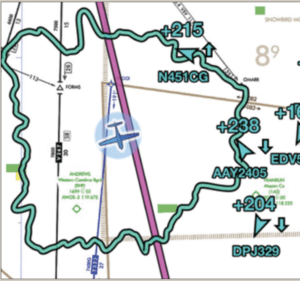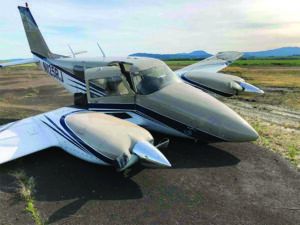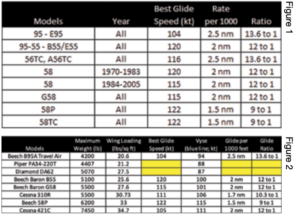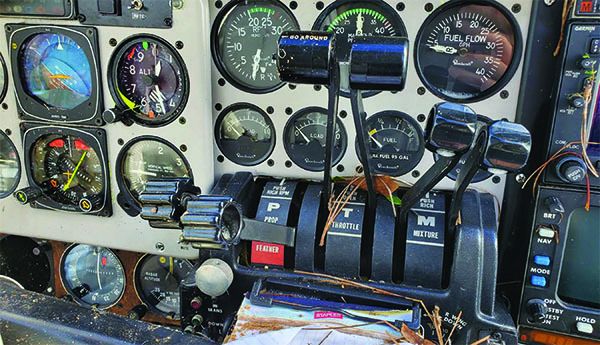Inflight failure of all engines in a multi-engine airplane is an emergency procedure we don’t talk much about. There’s a reason for that, of course: Not only is such an event considered a remote possibility, one of the underlying reasons to have more than one engine is to hedge against one of them failing. Yet, it happens. Author Ernest K. Gann regales readers of his classic Fate is the Hunter with not one but two tales of multiple engine failures happening to him when captaining four-engine airplanes.
With all that in mind, I presented a related scenario to Beech Baron pilots back when I was teaching in the FlightSafety International simulator at Beech Field. Flying along in cruise, in a lull between events, I “failed” both engines without warning—we briefed exhaustively before simulator sessions, but I wanted the “startle effect” of a condition the pilot did not anticipate, probably never considered and almost certainly never practiced, to see how the pilot reacted.
HOW AND WHY
You might be thinking, “The only situation that could result in both engines quitting at the same time is running out of fuel.” Sometimes it’s fuel exhaustion, completely running out of gas. There are usually four or five of these reported in piston twins each year in the NTSB record. At least as frequently, dual engine failure occurs from fuel starvation: management of independently selectable auxiliary tanks (which are pretty much universally prohibited for use in all but level flight), or when one or both engines are in crossfeed.
Other possibilities include fuel contamination. Jet fuel in a piston-powered airplane’s tanks usually destroys the engines almost immediately after takeoff—all indications may be normal before taking off. It’s also possible that an airplane’s auxiliary tanks could be misfueled when the mains were not, and simultaneous engine detonation could occur when the pilot switches to aux tanks in cruise flight. There are many other scenarios, such as fuel vents on both wings plugged by ice or flying into a flock of birds with an Airbus A320 shortly after taking off from LaGuardia.
But most things that can result in dual engine failure are preventable by the pilot—even fuel contamination, since the pilot can observe aircraft fueling and stop line service from putting the wrong fuel in the tanks. So why worry about dual engine failure in a twin? Because it can happen and has happened, and it almost certainly will happen again. Even if it’s your own fault that both engines quit, you still need to be ready to save yourself and your passengers. Survive now; assign blame later.

I frequently get this question: How do I determine the engine-out glide ratio for my airplane to input into ForeFlight (pictured at right), Garmin Pilot or other electronic flight bag software to create an engine-out glide ring display? If your POH/AFM has either a statement of glide performance (“2 nm per 1000 feet”) or a glide performance chart like the Cessna 310R, it’s easy to convert the data to a glide ratio.
Glide performance
If your handbook says the airplane will glide two nm per 1000 feet of altitude above ground, multiply 2 times 6000 (the number of feet in a nautical mile) and divide by 1000. This example has a 12:1 glide ratio.
Glide chart
If your manual has a chart that shows the airplane will glide 10 miles from 6000 feet above ground, multiply 10 times 6000 (60,000 feet traveled) and divide that by 6000 (altitude lost). The glide ratio in this case is 10 to 1.
CHECKLIST
The procedure for dual engine-failure glide is in the emergency procedures section of the pilot’s operating handbook (POH) for most, but not all, piston twins. My admittedly less-than-exhaustive search reveals glide information in the Beech POHs and owners manuals, the airplane flight manual (AFM) for Cessna 310s and 421s, and several others. I did not find any information about both-engines-out glide in the Piper Seneca V or Diamond DA62 manuals. The sidebar at right provides a generic checklist for twins when they lose both engines.
The emphasis, as it is in single-engine airplanes, is on reducing drag and flying the airspeed that results in the most horizontal distance for altitude lost—providing the greatest number of landing options. The things most pilots missed in the simulator was feathering both propellers for minimum drag and knowing the best glide speed to fly for the twin. Again, it’s not something we talk about doing in twins, and virtually never practice.
When a twin’s POH/AFM or other manual provides guidance for best glide performance, the common elements are:
• Flaps – UP
• Landing gear – UP
• Propellers – FEATHER
• Cowl flaps – CLOSED
• Speed – BEST GLIDE
The checklists list the best glide speed for maximum gross weight. Often there is a note referring to a performance section chart that lists the best glide speed for other airplane weights.
COMPARATIVE PERFORMANCE
We are usually drilled on best-glide procedure and performance in single-engine airplanes. Since the Beech twins I’m most experienced with are extremely similar to the single-engine Bonanzas—the extra Baron or Travel Air weight balanced by a slightly longer wing—we can do some performance comparisons to relate both-engine-out glide in a twin to the (hopefully) more familiar best-glide performance in a single-engine airplane.
In this low-drag configuration and on the proper airspeed, Beech Barons and Travel Airs have glide performance generally better than a Bonanza. Figure 1 on page 15 shows the best glide speed (in knots) for Beech piston twins, the vertical distance traveled for each 1000 feet of altitude loss and the resulting glide ratio. All figures come from the POH or owner’s manual, as appropriate, and assume maximum certificated weight and zero wind. Compare these figures with Bonanzas, which advertise a 1.7 nm per 1000 feet in a glide (except the long-wing B36TC, which nets two nm per 1000 feet). Despite their heavier weight, some Barons and especially Travel Airs glide farther than Bonanzas because feathering propellers results in less drag than a propeller even at the low rpm setting, which is the best you can do with an engine-out prop in a Bonanza. Only the 58P and 58TC get less distance from a glide than Bonanzas, but at maximum weight a 58P/58TC is 70 percent heavier than a max-weight G36.
MORE AIRPLANE TYPES
Unlike the Barons, the Cessna 310R AFM provides a glide performance chart. The chart includes changes in glide speed at different weights—because glide performance is a function of drag, and drag changes with angle of attack (AoA). Like most performance airspeeds provided, a 1G, least-drag AoA results from a lower indicated airspeed at lighter weights. Instead of merely stating the maximum weight glide performance (as the Beech manuals do), Cessna provides a chart that illustrates the maximum distance the airplane can glide for a given altitude, assuming zero wind.
For example, at 6000 feet above terrain, the C310R can glide 10 nautical miles. Perhaps surprisingly, the much heavier Cessna 421C has better glide performance: in the correct configuration on the proper airspeed it can glide 12 nautical miles from 6000 feet above terrain.
What if your POH/AFM provides no glide performance data (such as the Piper Seneca V and the Diamond DA62). In the unlikely event you find yourself without any power, what speed should you fly? What glide performance can you expect?

Most piston-twin POHs/AFMs do not publish an airspeed for landing without power. Some do, however. For example, the Diamond DA62 calls for 91 knots when landing out of a total loss of power at maximum weight with full flaps, compared to 89 knots in a normal max-weight landing. The Cessna 421 AFM suggests 105 knots at full flaps on final to a dead-stick landing, contrasted with 100 knots at maximum weight on a normal touchdown.
This is consistent with what we find in single-engine airplanes, which call for adding around five knots to the normal landing speed when landing without power. The reason is that even at idle power with all the engines working, there is some residual thrust and therefore some additional airflow from the propeller(s) over the elevator. This gives a little more control authority for a given indicated airspeed. At zero power, both in singles and in twins, there is less control authority for a given indicated airspeed. That, and the greater rate of descent that results in an engine-out glide, requires a faster final approach speed to have enough control authority to arrest that descent and flare before touching down.
It stands to reason, then, that barring other guidance you should adjust the attitude to slow the airplane to something about five knots faster than the normal landing speed when landing without power, assuming you carry extended flaps into your engine-out flare. If the flaps are still up, fly about five knots faster than the flaps-up landing speed.
In all cases, touch down wings level, under control, at the slowest safe speed that avoids a stall, to minimize impact forces on you and your passengers. With props-feathered drag significantly less than normal propeller drag during landing, you’ll float and (if wheels are down) roll longer than normal even at normal landing speed.
Lastly, as some manuals remind us, you might pop open cabin doors prior to touchdown to make after-landing egress easier. Secure loose items, shut off the fuel and, once in your landing configuration, turn off the battery and alternators/generators, and tighten shoulder harnesses. It might be useful to make and occasionally review a checklist for your airplane that covers all those items.
GLIDE EXPECTATIONS
The best answers I can provide come from comparing the characteristics of the airplane in question to known data from similar airplane types. Figure 2, at right, tabulates the known data from several light piston twins. The glide ratio may be inferred from POH/AFM data (see the sidebar on page 13). The empty fields in Figure 2, highlighted in yellow, are the “unknowns” from those manuals that do not provide these data.
In most, but not all cases, the published best glide speed, when it exists, is 10 to 20 percent faster than the airplane’s VYSE. The Cessna 421 is a notable exception. Barring guidance to the contrary, you might assume (bad word, I know) the best speed in a dual-flameout is five to 10 knots faster than your airplane’s blue line.
As for distance traveled in your glide, I suspect this is related to wing loading. If that’s valid, the Seneca V should glide a little more steeply than a Beech Travel Air but better than a B55 Baron—maybe about 2.2 nm per 1000 feet. The heavily wing-loaded DA62 should perform about like a G58 Baron, perhaps about two nautical miles for every 1000 feet of altitude. If these in fact are true, then the glide ratios would follow a similar pattern.
Can you safely test these ideas in your airplane? You might find a fellow pilot or flight instructor for an added level of safety, and on a smooth, clear day with light winds aloft, climb high above a long runway then put both engines into simulated zero thrust. Try a target airspeed five knots faster than blue line and find the resulting rate of descent. Using GPS, measure the groundspeed and horizontal distance you travel in 1000 feet of altitude loss. Repeat the exercise at 10 knots faster than blue line, and then at blue line speed. On the ground, review the data and see what speed gave you the best horizontal distance for 1000 feet of altitude loss. Using the groundspeed, you can dust off your trigonometry and adjust the angle of descent for zero winds (groundspeed equals your glide speed). All engine management caveats applied to “normal” use of zero thrust settings apply (there; I’ve made my disclaimer).
WIND AND GLIDE
The 1950s and ’60-era Beech Travel Air Owner’s Manuals have additional performance data for engine-out glide. The first-year manual includes a graph and suggests variations in glide ratio for various speeds (in miles per hour). In all subsequent Travel Air Owner’s Manuals, a table is supplied providing glide ratios, distance traveled per 1000 feet of altitude loss, and even different target airspeeds for glide with various mounts of headwind and tailwind. Other POHs/ AFMs may contain similar information.
That’s a lot to figure out after both engines suddenly quit, especially if you expend some of your altitude and time trying to get at least one of them restarted. As we do in single-engine airplanes, it’s best to fly the airspeed we remember and constantly re-evaluate our landing spot in a glide—especially in twins—which we almost never talk about.

PUSH AND HOLD
I teach Baron and Travel Air pilots to push the nose to the VYSE attitude and hold bank and heading with rudder at the onset of engine failure. In the scenario we don’t talk about, dual engine failure in a twin, we must respond as we do in a single: push the nose down to the glide attitude. In the Beech twins, and probably in other piston twins as well, this is about five degrees below the horizon—about what it looks like on a steep final approach—while holding bank and heading with rudder. After exhausting any restart attempts (if you have altitude, and therefore time to do so), feather both propellers, adjust the pitch to about level on the horizon, then tweak it up or down as needed to fly at the optimal speed. Optimal attitude targets will be about the same regardless of airplane weight, so if you fly the proper attitude, you’ll be close to the proper speed.
CAN WE TALK?
Dual engine failure is the emergency procedure we don’t talk about in light twins. Dual engine failure is rare and the cause is almost always pilot-preventable. Like other low-probability/high-consequence events, however, it’s worth thinking—and talking—about, so you know what to do if it happens.
Tom Turner is a CFII-MEI who frequently writes and lectures on aviation safety.




